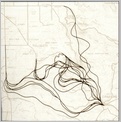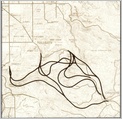PRINCES HIGHWAY - A history of the section from Adelaide to Tailem Bend |
|||||
Background |
The Princes Highway is the major artery between Adelaide, Murray Bridge and beyond, connecting with the Dukes Highway and Mallee Highway at Tailem Bend. This section of the Princes Highway is almost entirely freeway, with only the single carriageway Swanport Bridge breaking the dual carriageway conditions. However, it wasn't always like that and this is the story of its journey from bush track to grade-separated highway.
|
||||
Pre-1900 |
In 1841 a road from Adelaide to Mount Barker was surveyed and constructed, allowing settlement in the Adelaide Hills. A toll house was establised at Glen Osmond to toll the road, thus paying for its upkeep and maintenance. However, the state of the road was poor and a sustained public backlash caused the removal of the tolls in 1847 after the Government refused to upgrade it any further. In 1854 the first major realignment of the road was undertaken, improving the grades but creating the original Devil's Elbow corner. Later, between September 1867 and February 1868, a major deviation was constructed, with the new route bypassing the original Devil's Elbow via Overway Bridge. Thus, the Devil's Elbow name was transferred to a sharp corner near Mountain Hut, where it remains today. The Overway Bridge deviation was to be the last major work on the road for a long time as the importance of railways grew. In 1877 construction of the railway line through the Adelaide Hills began, reaching Aldgate in 1883 and Murray Bridge in 1886. The first bridge spanning the Murray River was completed in March 1879 at the town of Murray Bridge, carrying road and rail traffic from May 1886 until November 1925 when the rail-only bridge was opened. Until the rail-only bridge opened, traffic was being delayed for several hours at a time at the river crossing in order to allow trains to cross safely.
|
||||
Early 20th Century |
One of the first jobs of the Highway Department, formed in 1926 by the passing of the Highways Act, was to improve safety on the Mount Barker Road, particularly between Glen Osmond and Crafers. Thus, the road was sealed and linemarked in the late 1920s, a move which decreased incidents over the next few years. By 1936 the sealed road surface reached Murray Bridge. Despite the safety improvements, the road was clearly inadequate for the amount of traffic it carried and thus investigations began into ways of improving the Mount Barker Road (named Princes Highway in 1938).
|
||||
Plans for a Divided Highway between Glen Osmond and Crafers |
Following World War 2, urban planning kicked into swing in South Australia and thus attention was again focused on the Princes Highway. "In anticipation of increased traffic flow over the South Eastern Road [Princes Highway] and in recognition of its deficiencies, plans were made for its realignment. Known as the Burnside-Crafers Highway, the proposed realignment left Greenhills Road and proceeded up Linden Ave then ascended the side of Waterfall Gully to join the South Eastern Road above Eagle On The Hill. Work started during 1949/50 and was undertaken by Burnside Council over three years. This project was eventually abandoned in favour of reconstructing the existing South Eastern Road."1 Thus, construction commenced in the 1950s on duplicating the existing highway. Jack McInnes, the engineer who helped design the upgrade said of the project: "We were obliged to undertake total reconstruction and widening - from Crafers to Glen Osmond - at high cost and significant engineering difficulty - of several forms. The alignment was so poor that no standards existed...constrained within a creek bed for much of the lower section, we enclosed the creek - contrary to good practice. Blasting of rock faces, 'holding' the down side by construction of 'benches' were difficult and dangerous. And all the while we were required to maintain two lanes of traffic flow. It was, in my view, the most difficult and dangerous enginnering task the [Highways] Department attempted in my time there - made even more difficult by increasing and heavier traffic volumes and, every year, several months of rain and fog."2 Work began in October 1952. The first section at Eagle On The Hill was completed in December 1953, and the next year work continued up the hill to provide a 12m wide pavement. During 1955/56 a new deviation to form the westbound carriageway was built between Measdays Hill and Crafers (old highway alignment now part of Hillcrest Ave). This deviation became known as the "Mad Mile" due to its steep falling gradient and straight alignment about a mile in length. Once the idea for a Burnside-Crafers Highway was abandoned, reconstruction and widening of the most difficult section between Eagle On The Hill and Glen Osmond was commenced. Since it was impractical to construct temporary bypasses, the work was carried out alongside traffic. The first section reconstructed was from Mountain Hut (Devil's Elbow) to Young's Corner (300m south of Overway Bridge). Further down the gorge, between 1958 and 1960 the Glen Osmond Creek was regraded and diverted into concrete pipes between Glen Osmond Rd and Mt Osmond Rd. This section was also widened. As part of the works, the intersection with Cross Road and Portrush Road was signalised. The level of Cross Road was raised to 9m above Glen Osmond Creek to provide easy gradients for vehicles at the intersection, and the road widened to four lanes. The 1.2km section between Mt Osmond Rd and the Mountain Hut was constructed during 1959/60. The last section to be tackled was the one had always proved to be the most difficult in the Highway's history: the last climb up to Eagle On The Hill. Work started on this section between Young's Corner and Eagle On The Hill in April 1960 and was completed in June 1961.
|
||||
Rail proposal for the Adelaide Hills |
In February 1962, Leader of the State Opposition, Frank Walsh, proposed a 39-mile rail tunnel through the Mt Lofty Ranges to link Adelaide and Murray Bridge. Mr Walsh claimed that a senior engineer in the Engineering and Water Supply Department had advised him there would be no engineering problems and a senior geologist with the Mines Department had endorsed this advice. The existing rail route was 60 miles and a trip took 2.5 hours, while the proposed electrified railway through the tunnel would be 39 miles in length and take 45mins. Mr Walsh sought Commonwealth Grants for the project, pointing to similar schemes funded by the Commonwealth interstate (e.g. Snowy Mountains). Unfortunately nothing evenutated from this proposal, squashed by the freeway-centric planning of the time.
|
||||
South Eastern Freeway |
Following the duplication from Glen Osmond to Crafers, a solution was needed for the remainder of the Princes Highway from Crafers to Murray Bridge. The Highways Department proposed a new high standard, grade separated highway to replace the narrow, widning and tortuous route between Crafers and Mount Barker. Not long after, it was decided the freeway would extend to Callington. In October 1960 Minister for Roads, Norman Jude, introduced a bill to parliament anabling the Government to build freeways and operate them as controlled access roads. This paved the way fro the construction of the South Eastern Freeway. In February 1962 an American consultant was commissioned to advise the Highways Department on a proposed first section of the South Eastern Freeway. The Department had never constructed a freeway before and the concept had only recently been introduced to Australia so the American consultant brought some very valuable experience to the state. The preliminary designs were completed in May 1962 and released to the public. Some controversy erupted over the proposed first stage - from Crafers to Verdun - because the proposed route passed through Arbury Park. Opposition was found at a political level too from MP Alexander Downer - the freeway was proposed to pass by the front of his house. Downer offered to land behind his house to the Department for free but the adoption of a more northerly alignment behind Downer's house would have resulted in much higher construction costs and a greater scar on the landscape. Premier Thomas Playford listened to the opposition before meeting with the Commissioner for Highways who showed him that it was the only viable route. Downer eventually gave up the fight when he accepted a job in Port Augusta and relocated. Construction commenced in December 1965 however, due to ongoing negotiations regarding the route near Arbury Park, the first stage was limited to a 2km section from Measdays Hill to Stirling. This section consisted primarily of duplicating the existing Princes Highway, with a small deviation and grade-separated interchange constructed at Summit Road, Crafers. In February 1967 the northern (eastbound) carriageway was opened to traffic, although the section of freeway was not officially opened by the Minister for Roads and Transport until February 1969. The section was fully completed in May 1969 when the Crafers Interchange became fully operational. In February 1972 Commissioner for Highways, Keith Johinke, announced that the South Eastern Freeway would extend from Callington to bypass Murray Bridge, caliming that this would be cheaper than upgrading the existing road to a similar standard. However, the real reason for this extension was uncovered in November when Premier Don Dunstan announced a site near Murray bridge had been chosen for the new city of Murray, later renamed Monarto. The next stage, extending the freeway eastward behind Arbury Park and through Bridgewater to Verdun was completed in May 1972. This section was agruably the most important of them all as it bypassed the shopping strips of Stirling and Bridgewater as well as some narrow, winding and tortuous lengths of highway. Two years later, in December 1974, the freeway was extended from Verdun to Mount Barker, bypassing the small village of Hahndorf. The freeway reached Callington in December 1977, with National Highway 1 using a section of the Callington-Strathalbyn Rd to connect the freeway with Princes Highway (one sign remains). Because the South Eastern Freeway was proclaimed a National Highway in November 1974, future sections of the freeway were eleigible for federal funding. This enabled the freeway to be completed much sooner than if the State had been required to fund it. In May 1979, the South Eastern Freeway was completed, being extended east from Callington across the Murray River on the Swanport Bridge to join the Princes Highway east of Murray Bridge. The Swanport Bridge is the official terminus of the South Eastern Freeway (as it is single carriageway) and the remainder of the Murray Bridge bypass was known as the Swanport Deviation until the Princes Highway name was apllied to the entire route in 2000. Also, as part of the construction of the Swanport Deviation, the dual carriageway conditions were extended 22km east along the Princes Highway to Tailem Bend, including the bypass of the town centre.
|
||||
Adelaide-Crafers Highway |
|
||||
1. Cockburn, S., Ruff-Hewitt, M., Linn, R. & Stacey, B., Highway through the Hills: The Story of Mount Barker Road; 2000; p. 38-39
2. Donovan, P.; Highways: A History of the South Australian Highways Department; 1991; p. 143-144
3. Cockburn, S., Ruff-Hewitt, M., Linn, R. & Stacey, B., Highway through the Hills: The Story of Mount Barker Road; 2000; p. 52
4. Cockburn, S., Ruff-Hewitt, M., Linn, R. & Stacey, B., Highway through the Hills: The Story of Mount Barker Road; 2000; p. 53
5. Cockburn, S., Ruff-Hewitt, M., Linn, R. & Stacey, B., Highway through the Hills: The Story of Mount Barker Road; 2000; p. 60
6. Cockburn, S., Ruff-Hewitt, M., Linn, R. & Stacey, B., Highway through the Hills: The Story of Mount Barker Road; 2000; p. 64
7. Cockburn, S., Ruff-Hewitt, M., Linn, R. & Stacey, B., Highway through the Hills: The Story of Mount Barker Road; 2000; p. 66

